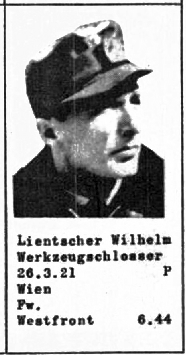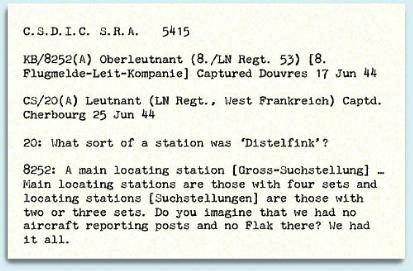|
8 June 1944 Fighter escort has the advantage for a Schlachtgruppe that the approach, dive, attack can be carried out bunched-up and undisturbed, departing as a group. If fighter escort is not provided, the Schlachtgruppe must approach in fighter formation, of necessity spread way out in the dive and is scarcely able to withdraw in a group. Discussions between Maj. Weyert and II. Fliegerkorps (10 February 1944) The German Seventh Army was told that the following Luftwaffe units had now arrived in its area (apparently moved in from Germany or other parts of France in response to the Invasion): 3./NAG 13 Again led by Weyert, eight Fw 190s took off against the beach head but ran into "eight Spitfires and eight Thunderbolts" just before they reached Argentan and were forced to jettison their SD 500 bombs. In the ensuing action, Fw. Krüger scored hits on a P-47 which left a strong smoke trail but one of the Gruppe's Focke-Wulfs was badly shot up. The unit was back on the ground at 11.15 hours but three pilots were still overdue at 09.30 the next day: Ltn. Becker, Uffz. Plewka and Fw. George whose aircraft had been a casualty of the 6 June combat (see above). Fw. Willi George is listed by the German War Graves Association as missing in the Caen area on 8 June. While the German Red Cross (DRK) simply records him as “missing, France , June 1944”, it adds that he was born in Dortmund on 22 August 1919. At 14.25 hrs. nine Fw 190s of I. and II./JG 1 took the air for an escort mission to "target area XW4E", followed a minute later by just four machines from the depleted III./SG 4 (with Obltn. Hesse leading) whose mission was to attack a bridge over the Orne Canal. In the face of intense light and medium AA fire, they dived from 1,200 metres and dropped two SD 500 and an SC 250, claiming two large explosions at the head of the bridge and a direct hit which destroyed it (so they believed). Although the Germans reported the presence of Thunderbolts and Mustangs (in the British sector?) they do not seem to have hindered the mission. On the receiving end, the British 6th Airborne Division recorded the attack in its War Diary: The enemy have appreciated the importance of the BÉNOUVILLE brs. A bombing attack registered a direct hit on the East br with a dud bomb at about 1600 hrs. The enemy arty [artillery] is endeavouring with repeated shelling to cap this achievement. The Division’s subordinate 6th Airlanding Brigade's timings differed: 1725: 20mm [gun] of defence platoon opened fire on bomb carrying Focke-Wulf. 1800: One of the bridges [was] bombed at approx 1700 hrs, damage not beyond unit repair. Bomb failed to explode. For the Royal Engineers’ 249th (Airborne) Field Company, the bridge was “unsuccessfully attacked by fighter bombers. UXB [unexploded bomb] on centre of BÉNOUVILLE bridge, 2 men wounded 14.00 hrs.” As reported to British Second Army by I Corps, bomb damage had left a 4 ft gap, but was the bridge remained passable by light vehicles. The evening mission took off at 17.50—five Fw 190 with Weyert at their head and each carrying an SC 500—briefed to attack three large freighters and 20 landing craft NW of Riva-Bella. This small force was escorted by three Fw 190 of I./JG 11, led by Ltn. Schrangel. Over the target at around 18.35, they dived from 1800 m and claimed that their bombs were on target but the five pilots were too busy evading the AA fire and 80 Allied fighters to ascertain further details. They were however able to report two “exceptionally big” landing forces off Riva-Bella and Lion-sur-Mer, consisting of about five freighters (3–5,000 GRT), 20 landing vessels (300 GRT) and 80 small landing craft. These were said to be accompanied by a cruiser and, 4 km to the north, an aircraft carrier (in fact no carriers were employed by the Allies). 9 June 1944 The ground elements of 7. /SG 4 arrived on the Invasion Front, flown in from Le Luc by three Ju 52s. The day's missions began with a low level sortie at 03.20 hours by nine Ju 88s of ZG 1 against unloading points between the Orne and Lion (SWORD Beach), each aircraft dropping 10 SC 50s despite powerful anti-aircraft fire and a balloon barrage. The defensive fire meant that were unable to observe results but a pair of NAG 13 Bf 109s were dispatched from Laval at 04.03 to cover the coast from the Orne to Arromanches (the British and Canadian landing beaches). From 04.05–04.20, 16 Focke-Wulfs from I. and II./JG 1 and five from III./SG 4 set out to attack unloading operations at Arromanches (GOLD beach) but were turned back by the weather, landing between 05.00 and 05.40. One of SG 4's aircraft was missing after this mission. At 04.10, III./JG 54 sent five Fw 190s to engage landings at the mouth of the Orne. At the same time, 11 Focke-Wulfs of JG 11 and four of III./SG 4 took off against SWORD Beach, followed 5 minutes later by 11 machines of JG 1. The Gruppe’s afternoon attack took off late after a broken landline between Rennes and Laval delayed the necessary orders. Fliegerführer West reported that a total of 43 fighter bombers, 46 fighters and eight reconnaissance machines had operated that day with five,16 and 2 respectively breaking off in the face of bad weather. Two aircraft were missing (one each from JG 1 and JG 11). Five aircraft had been damaged, Maj. Weyert’s being hit by AA fire and making an emergency landing near Flers. The III./SG 4 had been the only unit to report fighter defences and had encountered powerful and accurate AA of light and heavy calibres. During the day, the Quartermaster of Fliegerkorps II ordered III./SG 4 to dispatch "10 pilots not needed for operations" to the depot at "Airfield 112", probably to collect new aircraft. At 19.30 Fliegerführer West ordered preparations to be made for supply the strongpoint at Douvres-la-Délivrande. The intention was that III./SG4 should transfer to Étampes-Mondesir at daybreak to pick-up the supply containers. At 17.45 GMT an order was issued (it is not known by or to whom): "Dropping at 21.00 or at 01.00 hours. In the centre of the position, light three pyres or three bright lamps in an equilateral triangle".
Douvres was the location of a Luftwaffe radar station, Distelfink (goldfinch). This lay close to the coast between JUNO and SWORD beaches and been cut off since the Canadians and British joined up on the night of the 7 June. Its radars were out of action but its 200+ personnel still held out. Four Ju 88s of III./KG 54 were due to take off from tampes-ÉMondesir at 20.00 to drop supplies to the defenders. One of these failed to return and Fw. Wilhelm Lientscher’s crew (8./KG 54) were posted missing. That evening, an order was given to transfer personnel and equipment of 7./SG 4 to Laval. Also, III./SG 4 reported its strength as 18 (10) aircraft and 33 (19) pilots. Five of the unserviceable machines were expected to be operational again within five days. However, from 21.10 to 22.30 hours, an estimated 100–200 four-engined bombers, damaging four Fw 109s, hitting quarters and huts and rendering the airfield unserviceable. Next morning, it was reported that operations were impossible as the field was "heavily covered"with delayed action bombs but an alternative runway was being worked on urgently. A supplementary report issued at 16.00 on the 10th raised III./SG 4's losses to seven Fw 190s damaged. Among the these seems to have been Fw 190 A-7 W.Nr. 431121 which was taken over by the Laval Workshops for repair. continued on next page …
|
||||||||
PART FOUR OF NINE |
||||||||
 |
||||||||
 |
||||||||
Two members of the III./KG 54 Ju 88 crew missing from an operation to supply Distelfink on 9 June 1944. Images from Deutsches Rotes Kreuz Vermisstenbildlisten online |
||||||||


